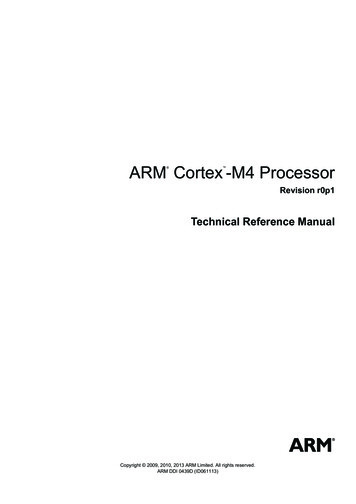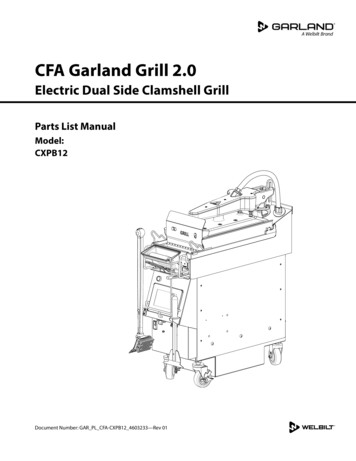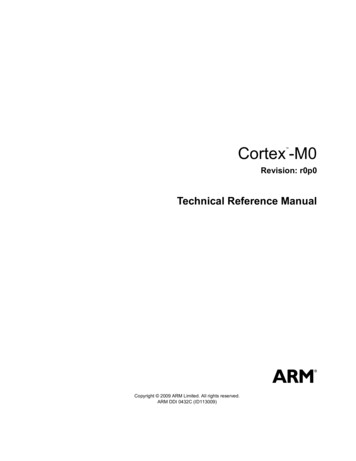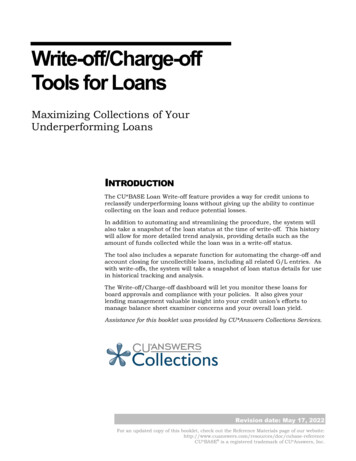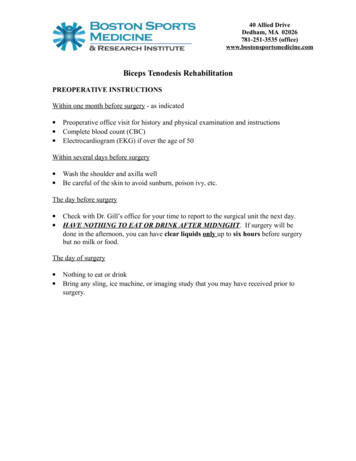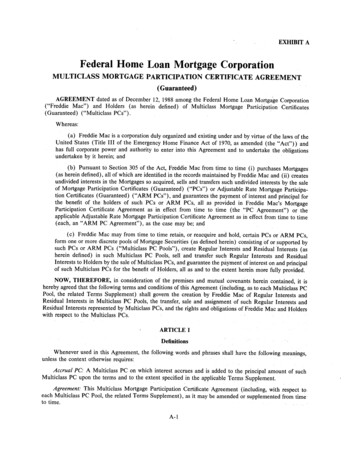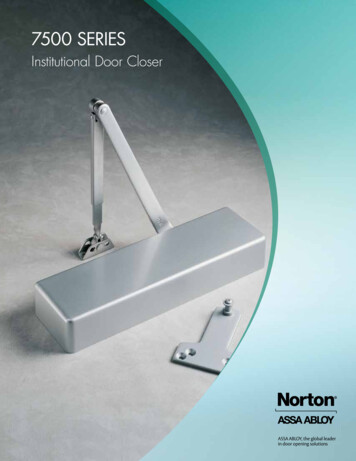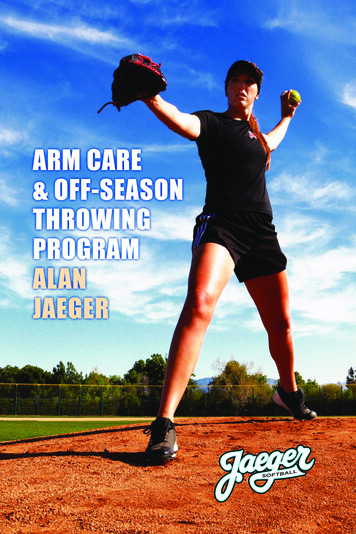
Transcription
Arm Care & Off-Season Throwing Manual Alan JaegerArm Care & Off-SeasonThrowing ManualAlan Jaeger
Arm Care & Off-Season Throwing Manual Alan JaegerWhat People AreSaying About Jaeger Softball“The Jaeger Throwing Program will provide the proper bio - mechanical foundationneeded to develop and sustain your throwing motion. A healthy arm, that maintainsstamina, is one of the most valued traits when college coaches are evaluating prospects.Invest in your arm, you’ve earned it.”Sue EnquistFormer UCLA Coach 27 years,11-time National Champion, 5-time Hall of Fame—————“We have been using the Jaeger Sports program religiously and see good results! Nogimmicks . just healthy arms that are getting stronger!”Mike CandreaHead Coach,The University of Arizona, 8 Time NCAA National Champions—————“We are really glad that we committed to the J-Bands and Long Toss Throwing Programthis past year. Arm Health and Arm Strength are so essential to the development of anysoftball players career. The time that we dedicated was extremely valuable as we didnot have to change practice plans or limit throwing reps due to sore arms throughoutthe season.”Kelly Inouye-PerezHead Coach, UCLA Bruins“The J-Band system, along with the Long Toss Throwing Program is a must for anyteam at any level. When our team had arm issues a few years ago, the irst change wemade was to purchase the J-Bands. Not only did we see a decrease in arm pain, butwe started to see a dramatic increase in arm strength and accuracy. Being a pitchingcoach, I really like the addition of Monica Abbott to the video and the new drills that thepitchers can do. I would highly recommend this program to anybody.”Dee Dee KingsburyHead Coach, Whittier College
Arm Care & Off-Season Throwing Manual Alan Jaeger“Over my 30 years of coaching at the collegiate level, I believe the J-Band programalong with the long toss warm up are the most complete daily activation to maximizeimprovements and minimize arm and shoulder issues. The daily commitment to theJ-Band and long toss program is time well spent and will keep athletes performing attheir peak levels far longer during a demanding season, with fewer days lost to injury,recovery, or rest from over use.”Kirk WalkerAssistant Coach, UCLA—————“We lat out use the Jaeger bands every day at practice as well as game days. It servesas a stretching, strengthening and preventative arm work out for our athletes. There isa direct correlation between the decrease of arm injuries in our program and the useof the Jaeger bands.”Kelly FordHead Coach, Cal State Fullerton Titans—————“Having coached both baseball and softball at the collegiate level, the Jaeger band isone training tool that I have used in each sport. I have seen the positive results in allathletes, and strongly believe that it is instrumental in keeping our athletes stronger andhealthier throughout the length of a season.”Jimmy KolaitisAssistant Coach, University of Oregon—————“J bands has the history, the reputation and the program that WORKS. The program issport speciic and easy to follow. GET ON IT TODAY.”Kama TuckerAssistant Coach, University, North Carolina Wilmington—————“I’ve been working with the Jaeger Sports, J-Band program for over 10 years. Thereisn’t a better program out there for Arm Care & Long Toss than the Jaeger program. Irecommend it to every player I come across.”Matt LisleHead Coach, Menlo College
Arm Care & Off-Season Throwing Manual Alan Jaeger
Arm Care & Off-Season Throwing Manual Alan JaegerAcknowledgementsMany thanks to everyone for their incredible support, including Jim Vatcher, China McCarneyand Tim Dixon for all of their help in too many ways to mention. To Monica Abbott, who hasgiven us invaluable feedback over the past two years, and has played an instrumentalrole in helping get our message of Arm Care and Throwing out to the Softball Community.To the following College Programs, for their trust (and feedback) to implement our ArmCare and Throwing Program: UCLA (Kelly Inyoue-Perez, Kirk Walker, Lisa Fernandez),University of Arizona (Mike Candrea), Cal State University, Fullerton (Kelly Ford andJorge Araujo) and Whittier College (Dee Dee Kingsbury). To Sue Enquist, for all you’vedone for us and for all you do to grow this great game of Softball. To Ed Halstead, forall of your support to help bring awareness to Arm Care and Throwing. To Greg Barnett,for all your time, help and artistry over the years, and for bringing this Manual to completion.To Devon Lindvall, thank you for all of your help with our program. To Derek Abramsonfor the many extra proofreads on short notice. Jim Beitia, thanks for all of your supportthrough the years. To Dee Dee Kingsbury, for your feedback in the 11th hour. And toeveryone who took time (on short notice) to look over all or parts of this Manual, includingSue Enquist, Monica Abbott, Kelly Ford, Matt Lisle, Amanda Scarborough, Kama Tuckerand Maria Winn, thank you so much.
Arm Care & Off-Season Throwing Manual Alan Jaeger“The J-Bands andLong Toss throwingprogram allow me tobest condition my armand pitch at mytop speed.”Monica AbbottPitcher, Chicago Bandits, 2007USA Player of the Year,2008 USA Olympic Team
Arm Care & Off-Season Throwing Manual Alan Jaeger
Arm Care & Off-Season Throwing Manual Alan JaegerForewordOne of the primary goals of every athlete is to optimize their skills and abilities. InSoftball, there is not a more important skill than throwing. Put rather bluntly, if you can’tthrow, you can’t play.But throwing is more than just being injury free. It should be the goal of every Softballplayer to ind out “what’s in your arm” -- to ind out how healthy, strong and durable yourarm can be. Considering that pitching wins championships, and defense clearly inluences games, it’s safe to say that throwing -- and more speciically, arm training anddevelopment -- should be given it’s proper due.Our philosophy toward throwing is simple -- the arm is waiting and willing to go to workfor us. It has so much potential and upside if given the time and attention. And contraryto opinions that suggest that you only have so many “throws in your arm”, we come froman entirely different school of thought whereby you “build” throws in your arm by throwing more, rather than less. Just as you don’t “count” how many steps you take eachday for fear of using them up, the arm responds best to activity, rather than inactivity.The arm is ready to go to work for you -- the questions is, are you ready to make theinvestment into it?As with the development of any skill our Throwing Program focuses on “base building”.Therefore, we spend a great deal of time from the onset building the arm up slowly andprogressively as a precursor to any aggressive throwing. Along with a dedicated ArmCare program, this is the most ideal way to build up the arm, and position it to be maintained rather effectively. And through our 25 years of experience and feedback in thebaseball community, and more recently, with a number of respected Softball Programs(UCLA, University of Arizona, Cal State University Fullerton, Whittier College) we havenot only seen and experienced the incredible beneits of a well trained arm, but likewise,how avoidable arm injuries can be if the arm is properly “Built Up” and “Maintained”.
Arm Care & Off-Season Throwing Manual Alan JaegerThis is best accomplished by understanding a few of our most essential principles upfront, namely: 1) That all arms are unique, 2) The importance of “listening to the arm”and allowing it to dictate what it needs from day to day, 3) The positive effects on an arm(Heath, Endurance, Strength and improved Recovery Period) by throwing more, ratherthan less, and 4) The importance of Arm Care and Long Toss.As you will see, iguring out “when” to start a throwing program and “how” to optimally“Build Up” an arm is the foundation of this Manual. Once a strong foundation is in placethe maintenance of the arm actually tends to take care of itself. And with a plan in placethat makes sense and is easy to follow it takes the guess work out, and gives you clarityand conidence as you make your way through the process.Once you implement and complete this Arm Care and Off Season Throwing Program,you may be pleasantly surprised how Healthy, Strong, Durable and Accurate your armcan become just by making a major investment into it.It’s simply amazing what our bodies (arms) are capable of doing if there is a clear anddirect intention toward training, along with a map that best gives us the guidance tonavigate that path. This Arm Care and Off Season Throwing Manual was written withthis in mind.Enjoy the process.Alan Jaeger
Arm Care & Off-Season Throwing Manual Alan JaegerTable of ContentsIntroduction -- Prioritizing Health and Conditioning.1Rule #1 of our Throwing Program: Listening to Your Arm.2The Role Of Long Toss.3Note: Warning Regarding Pull Downs.6Note Regarding Long Toss and Crow Hopping.6A Word About Arm Care And Band Work: Pre-Throwing(and Post Throwing) Arm Care Program.7Arm Circles.8Bands/Surgical Tubing Exercises.9Warning Regarding Band Work.10Post Throwing Arm Care.10The Throwing Program.11Target Date To Begin Your Throwing Program.11Phase 1 Overview: Stretching Out.12Phase 2 Overview: Stretching Out and Pulling Down.12The Throwing Schedule, Progression.14A Note Regarding Pitchers.15Week 1, Stretching Out Phase.16Week 2, Stretching Out Phase.20Week 3 (or 4): The Pull Down Phase.25Week 4 (or 5): Pull Down Phase.27Post Throwing Program Maintenance/Active Rest/Target DateFor Building Arm Up Again.28Mental Training and Throwing.28Resources: Arm Training/Sport Science/Strength and Conditioning.29
Arm Care & Off-Season Throwing Manual Alan JaegerIntroductionPrioritizing Health and ConditioningThe primary goal of any throwing program should be to put the arm in the bestposition possible to be healthy and well conditioned. The next priority is to buildstrength, athleticism and accuracy. We have found that the most ideal way to dothis is to irst build a strong base through a progressive build up of both volumeand distance by making low impact throws with an arc (as will be discussed lateron, Base Building is the First Phase of our Throwing Program, or what we call the“Stretching Out Phase”, consisting of the irst 2-3 weeks).This slow build up of volume with low impact throws is the most ideal way to buildup an arm. And by focusing the attention for the irst 2-3 weeks on “volume” (stacking the base) rather than trying to increase distance too quickly, the arm can trulybe positioned to not only get in shape in the most optimal way, but is best preparedfor the Second Phase of our Throwing Program, the “Pull-Down” or more aggressive phase of throwing (the subsequent 2 weeks after the initial 2-3 week Stretching Out Phase).Though, we are going to eventually want each athlete to start increasing their distance as the arm continues to open up, the idea is to get as much volume andendurance built up as possible, knowing that distance will simply come as a byproduct of building endurance, and allowing the arm to open up naturally.Stacking the base allows the arm to slowly and safely build up range of motion,endurance and freedom over an extended period of time. This initial phase is themost important part of our throwing program because it best positions the arm tonot only have a strong foundation, but again, sets the tone for the more aggressivephase of our throwing program (the Pull Down Phase).1
Arm Care & Off-Season Throwing Manual Alan JaegerRule #1 of our Throwing Program:Listening to Your ArmThe single most important principle of our throwing program is to “Listen To YourArm”. All players are unique so we do not like the idea of having a one size its allprogram. Therefore, please note that despite the incremental throwing programthat has been suggested in this Manual, we prefer that all players throw accordingto what feels right from day to day. This throwing format is simply a guide -- it stillwill come down to how each individual feels, and at what pace each players armbegins to “open up” and get into shape.We do feel that initially, there should be a heavy emphasis on more throws ratherthan less at shorter distances, especially in the irst 2-3 weeks. But “at what pace”players go out away from their throwing partner, “how” many throws they make ateach increment, and “how” many throws they make on the way back in toward theirthrowing partner is really up to the individual. Thus, when a player starts a throwing program their arm is the charge and it will let them know how quickly or slowlythey need to progress. There is no right or wrong answer when it comes to time,distance or amount of throws on a given day of throwing.Again, at the bottom of this Manual, you will ind our guidelines for our throwingprogram based on a 4-5 week cycle. But the key is to irst teach each player theimportance of “Listening to their Arm”, and use the suggestions laid out in thethrowing program as a reference. Ultimately, the arm will always dictate what itwants, and what it needs on a given day.2
Arm Care & Off-Season Throwing Manual Alan JaegerThe Role of Long TossNaturally, the single most important course of action you are going to undertake foryour arm is throwing. And for us, there is no substitute for throwing, throwing often,and training your arm how to extend out, progressively, to it’s furthest potential distance (Stretching Out) and then learning how to translate that distance (extension)into aggressive and explosive throwing in a safe manner (Pulling Down).This is what we call Long Toss.Our Long Toss routine has two major components: the Stretching Out Phase (moving away from your partner), and the Pulling Down Phase (coming back in towardyour partner). The “Stretching Out Phase” is just that stretching. And the mostideal way to “stretch your arm out” is by throwing the ball with arc as you slowlymove away from your throwing partner.Throwing with arc allows the arm to experience several health beneits, includingfreedom and range of motion. Also, by throwing with arc you are allowing the armto stretch out, progressively, at different angles, while making “low impact” throws.This promotes a sense of relaxation because you are throwing with ease from theonset, rather than starting out by throwing the ball aggressively and/or on a line.This “stretching out” phase of Long Toss is not only the most ideal way to “open thearm up”, but it best positions the arm for the more aggressive, downhill phase ofthrowing, or what we call “Pulling Down”.The Second Phase of Long Toss is the “Pull Down” or Strengthening Phase. Thegoal here is that once the arm has been completely stretched out and well conditioned the arm is ready for aggressive throwing, or “Pulling Down” (keep in mindthat just as we progressively built up the Stretching Out Phase, we also want tointroduce the Pull Down phase, progressively).3
Arm Care & Off-Season Throwing Manual Alan JaegerThe way the Pull Down Phase works is that once an athlete knows that they are inideal shape because they have reached their maximum distance in the Stretching OutPhase (a good barometer is that they are able to make a few throws comfortably at theirmaximum distance), they would then come back in toward their throwing partner approximately 5 feet per throw, while maintaining the same effort or intent of their furthestthrow (assuming it is a Pull Down day).Therefore, if a player went out to 180 feet on a given day the goal would be to maintainthe same effort or “intent” of their 180 foot throw all the way back in toward their throwing partner. We like to use the analogy that if 180 feet were equal to “x”, then everythrow coming back in toward your throwing partner is also equal to “x”. Naturally, theonly thing that changes is that the arc (and aim) gets lower.Though, we want you to come back in toward your throwing partner in 5 foot increments, this is an arbitrary number. Ultimately, since you are making the same throw or“x” all the way back in to your throwing partner (remember, the only thing is changing isthe release point as you get closer), it’s up to you how slowly or quickly you come backin. 5 foot increments are ideal because the change in release point is minimal and players can make a smooth transition as they get closer to their throwing partner.Whereas, the irst goal of the Pull Down phase is to maintain the same distance of yourfurthest throw or “not” decelerate, the second goal of the Pull Down phase is to misslower rather than higher. Missing lower than higher promotes two important beneits.Since it’s more dificult to “compress” your entire distance (“x”) into shorter distancesas you get closer, you are essentially forced into iguring out how to organize your bodyin an extremely eficient and effective way mechanically that promotes “getting out infront”, and having great downhill angle (because if you decelerate at all, the ball willtend to be high or over your partners head).Another major beneit is relaxation and balance -- when the mind knows it must miss“lower, rather than higher”, it can actually be very relaxing to the mind and body becauseplayers can eliminate the number one, subconscious concern of two players playingcatch “I don’t want to throw the ball over my partners head” (this is also a major reasonwhy players will ease up or “decelerate” their throws coming back in toward their throwing4
Arm Care & Off-Season Throwing Manual Alan Jaegerpartner -- they simply don’t want to play chase, which also brings into play the issue ofwasting time, or simply “not playing catch”).Though, it may be a bit dificult to igure out how to Pull Down correctly if you are new tothis approach, you can really train your body/arm/mind what it means to accelerate ratherthan decelerate through your throw, and use the arc from the stretching out phase as abeneit to promote a great downhill plane.When you truly learn the art of translating a great deal of distance of uphill throwing(30 degrees or so ) into downhill throwing at a very short distance (ie 70 feet), withoutdecelerating and have the ball end up at your partners ankles, it is a magical feeling. It’swhat we feel like is the perfect throw because you have to have a combination of idealmechanics (relaxation, balance, alignment, direction, extension, leverage, athleticism,explosiveness, and inish) and repeatability (because when the body/mind has beentrained to maintain the constants of intent, acceleration and commitment, the releasepoint can most ideally repeat).Though, it may be more dificult, at irst, to igure out how to compress such a hugedistance (180 feet or more) of uphill throwing into a target below the knees at closerange (70 feet), without decelerating the arm, this form of training can really force youinto getting mechanically synched, and repeatable. And when you are able to do thisconsistently on lat ground, where’s it’s more dificult to get downhill, the effect on howthis translates can be profound. You may ind yourself getting downhill better than youever have in your life as a by-product of learning the value of training your body tothrow uphill prior to throwing downhill (not so ironically, pitching coaches in baseballhave a drill for pitchers who are having a dificult time “getting extended over their frontside” whereby they have pitchers stride uphill on the back of the mound to practice getting better extension over the front side).It is important to have a clear understanding of both the Stretching Out and Pulling Downphases of our Long Toss approach going forward. As we begin Phase 1 of the throwing progression (The Stretching Out Phase), it is important to know the distinction between “Stretching the arm out” (weeks 1-3) and “Pulling Down” (beginning, approximately in week 4).5
Arm Care & Off-Season Throwing Manual Alan JaegerThough, we would never want to make a blanket statement as to what “everyone”should do, we strongly encourage players to Long Toss for countless reasons, including:Health, Conditioning, Endurance, Arm Strength, Athleticism, Mechanical Synch, Feel,Freedom, Accuracy, Arm Speed, Explosiveness, Mind/Body Connection, Creativity andPhysical and Mental Relaxation. Long Toss has been at the core of our throwing philosophy in the baseball community for the past 25 years, and we have also seen ittranslate well into the Softball community.Note: Warning Regarding Pull Downs -- as you begin to get the feel for what it meansto Pull Down without decelerating on the way in toward your throwing partner, you mayind a whole different level of “life”, “explosion” and “carry” on the ball. For this reason,we want to make sure that you are clearly aware of the danger of getting too close toyour partner at the end of the Pull Down Phase. Though, there are a number of beneitsfor accuracy, explosiveness and mechanical reasons to get close to your partner without decelerating, for safety reasons, we urge you to have a geared up catcher, with aface mask, to inish your pull down work as you closer to your partner (anything closerthan 70 feet). Please prioritize safety.Note Regarding Long Toss and Crow HoppingHow you use your legs when throwing a softball plays a huge role in both taking theemphasis off of your arm, and promoting athleticism. For this reason, we strongly recommend that you begin to “crow hop” as soon as possible in your throwing session, andmaintain it through the end of the throwing session.Though there are many different ways to crow hop, and many different ways to moveyour legs based on your position, we strongly recommend, for several reasons, thatyou crow hop off your right leg if you are right handed, and left leg if you are left handed(see link for the proper crow hop at the 1 minute mark: https://www.youtube.com/watch?v oB7IcMy5Q0s).The reason why we want you to crow hop this way is to best support and protect yourarm during Long Toss. To whatever degree that you “come out” of your position speciicleg work and arm circle can be corrected rather effectively once your Long Toss sessionis over simply by going back out to your position speciic distance, and working on your6
Arm Care & Off-Season Throwing Manual Alan Jaegerspeciic mechanics (leg work and arm circle) consistent with your position . And inally,besides safety, this style of crow hop promotes balance, extension and athleticism,regardless of what position you play.Long Toss plays such a huge role in both the Off-Season Build Up and the In-SeasonMaintenance Periods, and our throwing philosophy in general. For more information about both the Stretching Out and Pull Down phases of Long Toss, you canview our Long Toss demonstration for position players (https://www.youtube.com/watch?v 9w3xwYIx17s) and our underhanded Long Toss demonstration for pitchers(http://www.youtube.com/watch?v UQHnKRQ9s0I) on Youtube. Ironically, the formof crow hop being used in the position player video is a “shufle step”. As mentioned inthe section above, we strongly recommend that you Crow Hop off of your back leg (rightfoot for righthanders, left foot for lefthanders). Again, please refer to the 1 minute markof the following video to see the proper way to crow hop (https://www.youtube.com/watch?v oB7IcMy5Q0s).A Word About Arm Care And Band Work:Pre-Throwing (and Post Throwing) Arm Care ProgramBefore we introduce the Throwing Program, let’s take a moment to address the importance of having a pre-throwing Arm Care Program, or what we call Pre-Habilitation, inplace. There are many great ways to prepare the arm to throw. The program we havetaught for the past 20 years speciically targets the shoulder and surrounding areas,and is based on Arm Circles and Band work (though, we don’t speciically address theelbow, we highly recommend that you check out our resource page at the bottom of thisManual for more information about elbow care, and arm care in general).These two components are essential to the preparation of the arm, immediately priorto throwing. And we do not let players pick up a softball without going through thesetwo steps (Note: this does not preclude the fact that there are other helpful ways toprepare the arm -- again, please refer to our resource page at the end of this manual.Also note that we always want our players to do some form of cardio prior to their ArmCare Program).7
Arm Care & Off-Season Throwing Manual Alan JaegerThe following two sections will go over our Arm Circle and Band program in detail (formore information about our Arm Circle, Band Work-Out and Long Toss Routine, youcan reference our DVD, Thrive On Throwing 2: aeger-Sports/).Arm CirclesOur Arm Care program is comprised of two stations -- station one is Arm Circles, whichis a “general” range of motion workout, that targets the shoulder and surrounding muscle groups (Macro) followed by station two, which is a Surgical Tubing or Band workout (Micro) that targets more speciic areas of the shoulder, including, the rotator cuffmuscle group and other supportive areas of the shoulder.The Arm Circle routine comprises of two sets, palms facing downward with forwardrotation, followed by palms facing upward with backward rotation. Both sets of Arm Circles are a precursor to the Band workout because they address the most basic needs ofthe arm: blood low, oxygen, range of motion and heat to the rotator cuff muscle groups,and supporting areas. This literal “warm up” of the shoulder and surrounding areas ideally prepares the shoulder area for the Band work out.Each set of Arm Circles has 9 checkpoints (small, quarter, half, three quarter, full, threequarter, half quarter, small). Just as we begin our throwing program slowly and gradually, we do the same with Arm Circles. We’ll have our players start with 8 repetitions atall 9 of these checkpoints (72 repetitions total) and increase to 12 repetitions (once 12is mastered, you can add a ball and go back to 8 repetitions and work up to 12 repetitions again).In addition to these 9 checkpoints, we also have a few other guidelines to insure thatyou are doing the Arm Circles properly, including: 1) Be sure that your arms are extending out away from the body at shoulder height with a slight bend in the elbows to relaxyour arms, 2) Be sure that your middle ingers (from both arms) form a line segmentfrom one tip to the other through your shoulders, 3) Try and keep your shoulders andsurrounding areas as relaxed as possible (a good idea is to imagine that your circlesare moving through “soft space”), 3) As you rotate your arms, be sure that you are8
Arm Care & Off-Season Throwing Manual Alan Jaegermaking symmetrical circles, ie, as high as you are low, and as far backward as you areforward (because the tendency is to have your shoulders lean fwd, be sure to be awareof working backward as much as forward), and 4) Be aware of keeping your breathingas luid as possible (ie avoid holding your breath) try to keep your body and mind asrelaxed as possible.If at any point you ind that your technique breaks down stop and take a break andeither inish later, or know that you need more time (or less repetitions) to build upyour endurance properly (For more information and a visual demonstration regardingArm Circles, please go to the following link on Youtube: https://www.youtube.com/watch?v OvuzuJunwgs -- please note that this shows only the irst set of Arm Circles,Palms down and forward. Again, our entire Arm Circle routine can be seen on our DVD,Thrive On Throwing 2).Bands/Surgical Tubing ExercisesIt’s hard to put into words the value and effect of Band work. Though Bands or Surgical Tubing has been around for many decades, the concept of using them tended torevolve around post surgery, rehabilitation. Though, Bands play a huge role in helpingthe athlete rehabilitate his or her arm back in shape, we have found that doing Bandsprior to throwing is extremely beneicial and effective.Just as players have to do a very thorough Band program to get their arms extremelyhealthy post surgery, we love the concept that by doing Bands irst, you are actuallydoing “Pre-habilitation”. We can tell you from irst hand experience and from countlessplayers and coaches that the beneicial effects on the arm
"We lat out use the Jaeger bands every day at practice as well as game days. It serves as a stretching, strengthening and preventative arm work out for our athletes. There is a direct correlation between the decrease of arm injuries in our program and the use of the Jaeger bands." Kelly Ford Head Coach, Cal State Fullerton Titans
